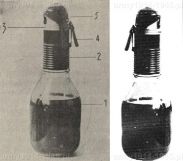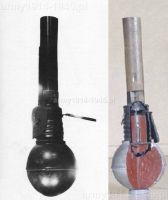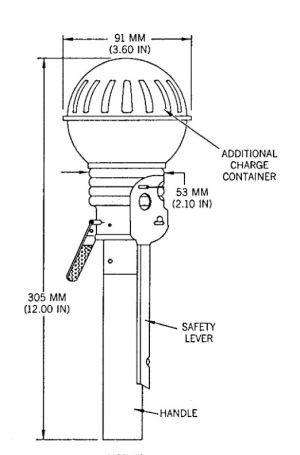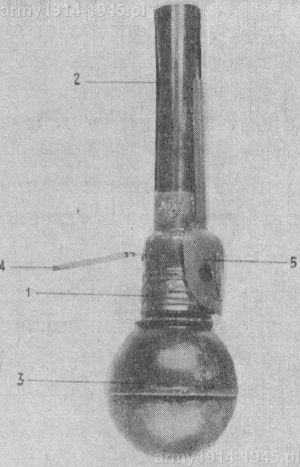Parent category: Armament, equipment and equipment Regio Esercito (Italy)
OTO Mod.42 anti-tank grenade, a professional “Molotov cocktail”
Author: Maciej Tomaszewski
![]()
The OTO modello 42 was not a makeshift “Molotov cocktail”, but a deliberately and from scratch designed to fight tanks, an incendiary grenade. The bottle was designed and produced deliberately for this grenade, along with a sleeve that allows it to be combined with the OTO Modello 35 offensive grenade. A small hand fragmentation grenade acting as an ignition multiplier had an impact fuse and thus caused an explosion and ignition of the entire mixture as a result of hitting the target. The entire grenade was 300 mm high and the largest diameter was 100 mm. The OTO Modello 42 incendiary grenade had a total weight of 1.1 kg and contained 600 cm3 of flammable mixture. Soldiers were trained to target the air intakes to the engine compartment or other gaps in the tank. The grenade was useful when storming fortifications or combat shelters. The only thing that is puzzling is the low content of the flammable mixture, because usually, 1-1.5 liter bottles were recommended to fight tanks.
Granat przeciwpancerny Breda Mod. 42 (Regio Esercito) (technique).
Details
Parent category: Armament, equipment and equipment Regio Esercito (Italy)
When the war broke out, it turned out that the interwar calculations did not come true and it would not be conducted in the Alps. Quickly, the burden of land fighting moved to North Africa, and there you were spawned by larger and more heavily armored Allied tanks. In addition, Mussolini, at his own request, maneuvered his empire into a war with Russia, and there tanks “skolko ugodno” (сколько угодно) and new T-34s.
Author: Maciej Tomaszewski
![]()
The Italians urgently needed anti-tank grenades. Breda Mod grenade was used. 40, which was created by adding a handle to the Breda Mod.35 grenade. Quite simply, a spherical explosive charge was also applied to it, for which the grenade was the detonator. This is how the Breda Modello 42 grenade was created. The grenade was 305 mm long and had the largest diameter of 92 mm. It weighed 1247 grams, of which the explosive charge was as much as 1000 grams (according to another source, there were 574 grams of explosive in the additional warhead, which together with 63 grams in the initiating grenade would give 637 grams of TNT). It was assumed that it could be thrown at 10-15 m and it was recommended that after throwing the grenade, the soldier should fall flat to the ground to protect himself from the effects of the explosion, but it would be better for the thrower to be far from the explosion site, but preferably behind a solid cover. The minimum distance from the target was to be 5-8 m, otherwise the force of the explosion alone could shock the thrower. The second stage of protection of the grenade, which was supposed to be the initiator of the explosion of the main charge, caused the grenade to arm after flying the first 10-12 m, i.e. the anti-tank grenade. It was designed to attack targets 15 m away from the thrower. The grenade inside, which was the initiator of the whole, i.e. Breda Modello 35, was armed only after about 0.8-1 second from throwing. Two-stage protection of Italian grenades is discussed in the article about Breda Mod.35 grenade. According to information from Wikipedia, in June 1942 the first batch of such anti-tank grenades (10,000 pieces) was produced. Unfortunately, according to numerous defects, they did not pass the qualification tests until April 1943. Finally, a version without double protection and classically with a pin and a spoon was approved for production. Thanks to this, the grenade could not explode as long as it was in the hands of the thrower, but after that, any hit on an obstacle could cause an explosion. Such a grenade had no limit in the minimum throw distance, except, of course, for the safety of the soldier throwing it, which he had to take care of himself.
As for the armor’s penetration, the grenade exploded 20 mm armor plates, but the force of the explosion, according to the Italians, was to have such a strong effect on the thicker armor that large fragments dangerous to the tank’s crew and engine were to break off from the 30-40 mm plates as a result of the passage of the shock wave through them (according to other data, this was the case with 30 mm armor plates).
![]()
Legal basis: The article has didactic and scientific tasks and aims to promote knowledge and critical analysis, in order to clarify all the facts. The author reserves the right to use forms of fair public use, such as the right to quote. However, all persons who would consider themselves aggrieved are asked by the author to contact him in order to clarify and possibly remove works that would be covered by property rights.



